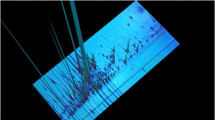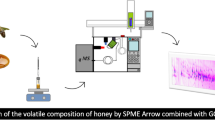Abstract
The present paper discusses the use of a high-concentration-capacity tool, HiSorb, to investigate the impact of capsule material on the aroma profile of espresso-brewed coffee. The specific high-concentration-capacity probe used is characterized by a sorbent volume (63 μL) intermediate between the solid-phase microextraction (SPME) fiber (0.6 μL) and the stir-bar sorptive extraction rod (126 μL). The extraction performance of the HiSorb was compared, in terms of both absolute signal and compound coverage, with both an equivalent sorbent (polydimethylsiloxane) and a divinylbenzene/carboxen/polydimethylsiloxane SPME fiber using both targeted and untargeted approaches. The HiSorb showed superior extraction compared with the SPME fibers. The HiSorb was then optimized in terms of extraction time and temperature and used to investigate the volatile profile of 23 espresso-brewed coffees prepared with capsules made of different materials—aluminum, compostable, and aluminum multilayer pack—prepared using a refillable capsule. Comprehensive two-dimensional gas chromatography equipped with a reverse fill/flush flow modulator and coupled to mass spectrometry was used to obtain a chromatographic fingerprint of the volatile profile of the brewed coffee. The data were aligned and compared using a tile-based approach, and the results were obtained by performing raw data mining within the same software platform. The data mining enabled the extraction of informative features responsible for the differentiation between the different capsule materials, showing a significant depletion in aroma intensity in the compostable capsule.





Similar content being viewed by others
References
Pawliszyn J. Handbook of Solid Phase Microextraction, First. London: Elsevier Inc.; 2012.
Gałuszka A, Migaszewski Z, Namieśnik J. The 12 principles of green analytical chemistry and the SIGNIFICANCE mnemonic of green analytical practices. TrAC - Trends Anal Chem. 2013;50:78–84. https://doi.org/10.1016/j.trac.2013.04.010.
Nowak PM, Wietecha-Posłuszny R, Pawliszyn J. White Analytical Chemistry: An approach to reconcile the principles of Green Analytical Chemistry and functionality. TrAC - Trends Anal Chem. 2021;138:116223. https://doi.org/10.1016/j.trac.2021.116223.
Baltussen E, Sandra P, David F, Cramers C. Stir bar sorptive extraction (SBSE), a novel extraction technique for aqueous samples: Theory and principles. J Microcolumn. 1999;11:737–47. https://doi.org/10.1002/(SICI)1520-667X(1999)11:10<737::AID-MCS7>3.0.CO;2-4.
David F, Ochiai N, Sandra P. Two decades of stir bar sorptive extraction: A retrospective and future outlook. TrAC - Trends Anal Chem. 2019;112:102–11. https://doi.org/10.1016/j.trac.2018.12.006.
Kremser A, Jochmann MA, Schmidt TC. PAL SPME Arrow - Evaluation of a novel solid-phase microextraction device for freely dissolved PAHs in water. Anal Bioanal Chem. 2016;408:943–52. https://doi.org/10.1007/s00216-015-9187-z.
Helin A, Rönkkö T, Parshintsev J, Hartonen K, Schilling B, Läubli T, Riekkola ML. Solid phase microextraction Arrow for the sampling of volatile amines in wastewater and atmosphere. J Chromatogr A. 2015;1426:56–63. https://doi.org/10.1016/j.chroma.2015.11.061.
Scheuler KH, Schilling C (2014) Extraction Device. US 20140220701 A1, n.d.
Herrington JS, Gómez-Ríos GA, Myers C, Stidsen G, Bell DS. Hunting molecules in complex matrices with spme arrows: A review. Separations. 2020;7:12. https://doi.org/10.3390/separations7010012.
Elia S, Stylianou M, Agapiou A. Aroma characterization of raw and electrochemically treated goat whey wastewater. Sustain Chem Pharm. 2022;27:100640. https://doi.org/10.1016/j.scp.2022.100640.
Cheng Z, Mannion DT, O’sullivan MG, Miao S, Kerry JP, Kilcawley KN. Comparison of automated extraction techniques for volatile analysis of whole milk powder. Foods. 2021;10:1–19. https://doi.org/10.3390/foods10092061.
Faulkner H, O’Callaghan TF, McAuliffe S, Hennessy D, Stanton C, O’Sullivan MG, Kerry JP, Kilcawley KN. Effect of different forage types on the volatile and sensory properties of bovine milk. J Dairy Sci. 2018;101:1034–47. https://doi.org/10.3168/jds.2017-13141.
Clarke HJ, Fitzpatrick E, Hennessy D, O’Sullivan MG, Kerry JP, Kilcawley KN. The Influence of Pasture and Non-pasture-Based Feeding Systems on the Aroma of Raw Bovine Milk. Front Nutr. 2022;9:841454. https://doi.org/10.3389/fnut.2022.841454.
Grabež V, Egelandsdal B, Cruz A, Hallenstvedt E, Mydland LT, Alvseike O, Kåsin K, Ruud L, Karlsen V, Øverland M. Understanding metabolic phenomena accompanying high levels of yeast in broiler chicken diets and resulting carcass weight and meat quality changes. Poult Sci. 2022;101:101749. https://doi.org/10.1016/j.psj.2022.101749.
Lee Díaz AS, Rizaludin MS, Zweers H, Raaijmakers JM, Garbeva P. Exploring the Volatiles Released from Roots of Wild and Domesticated Tomato Plants under Insect Attack. Molecules. 2022;27:1612. https://doi.org/10.3390/molecules27051612.
Zanardi OZ, Volpe HXL, Luvizotto RAG, Magnani RF, Gonzalez F, Calvo C, Oehlschlager CA, Lehan BJ, Esperança V, Delfino JY, de Freitas R, de Carvalho RI, Mulinari TA, Miranda MP, Bento JMS, Leal WS. Laboratory and field evaluation of acetic acid-based lures for male Asian citrus psyllid, Diaphorina citri. Sci Rep. 2019;9:1–10. https://doi.org/10.1038/s41598-019-49469-3.
Alberti S, Sotiropoulou M, Fernández E, Solomou N, Ferretti M, Psillakis E. UV-254 degradation of nicotine in natural waters and leachates produced from cigarette butts and heat-not-burn tobacco products. Environ Res. 2021;194:110695. https://doi.org/10.1016/j.envres.2020.110695.
Brown RW, Mayser JP, Widdowson C, Chadwick DR, Jones DL. Dependence of thermal desorption method for profiling volatile organic compound (VOC) emissions from soil. Soil Biol Biochem. 2021;160:108313. https://doi.org/10.1016/j.soilbio.2021.108313.
Hearn L, Cole R, Spadafora ND, Szafnauer R. Volatile and semi-volatile compounds in flavoured hard seltzer beverages: Comparison of high-capacity sorptive extraction (HiSorb) methods. Adv Sample Prep. 2022;3:100032. https://doi.org/10.1016/j.sampre.2022.100032.
Wang X, Wang Y, Hu G, Hong D, Guo T, Li J, Li Z, Qiu M. Review on factors affecting coffee volatiles: from seed to cup. J Sci Food Agric. 2022;102:1341–52. https://doi.org/10.1002/jsfa.11647.
Angeloni S, Mustafa AM, Abouelenein D, Alessandroni L, Acquaticci L, Nzekoue FK, Petrelli R, Sagratini G, Vittori S, Torregiani E, Caprioli G. Characterization of the aroma profile and main key odorants of espresso coffee. Molecules. 2021;26:1–29. https://doi.org/10.3390/molecules26133856.
Semmelroch P, Grosch W. Studies on character impact Odorants of coffee brews. J Agric Food Chem. 1996;44:537–43. https://doi.org/10.1021/jf9505988.
Blank I, Sen A, Grosch W. Potent odorants of the roasted powder and brew of Arabica coffee. Z Leb Unters Forsch. 1992;195:239–45. https://doi.org/10.1007/BF01202802.
Bressanello D, Liberto E, Cordero C, Rubiolo P, Pellegrino G, Ruosi MR, Bicchi C. Coffee aroma: Chemometric comparison of the chemical information provided by three different samplings combined with GC–MS to describe the sensory properties in cup. Food Chem. 2017;214:218–26. https://doi.org/10.1016/j.foodchem.2016.07.088.
Cordoba N, Fernandez-Alduenda M, Moreno FL, Ruiz Y. Coffee extraction: A review of parameters and their influence on the physicochemical characteristics and flavour of coffee brews. Trends Food Sci Technol. 2020;96:45–60. https://doi.org/10.1016/j.tifs.2019.12.004.
de Figueiredo Tavares MP, Mourad AL. Coffee beverage preparation by different methods from an environmental perspective. Int J Life Cycle Assess. 2020;25:1356–67. https://doi.org/10.1007/s11367-019-01719-2.
Greco G, Núñez-Carmona E, Abbatangelo M, Fava P, Sberveglieri V. How coffee capsules affect the volatilome in espresso coffee. Separations. 2021;8:248. https://doi.org/10.3390/separations8120248.
Lolli V, Acharjee A, Angelino D, Tassotti M, Del Rio D, Mena P, Caligiani A. Chemical Characterization of Capsule-Brewed Espresso Coffee Aroma from the Most Widespread Italian Brands by HS-SPME/GC-MS. Molecules. 2020;25:1166. https://doi.org/10.3390/molecules25051166.
Bicchi C, Iori C, Rubiolo P, Sandra P. Headspace sorptive extraction (HSSE), stir bar sorptive extraction (SBSE), and solid phase microextraction (SPME) applied to the analysis of roasted Arabica coffee and coffee brew. J Agric Food Chem. 2002;50:449–59. https://doi.org/10.1021/jf010877x.
Massart D. Chemometrics : a textbook. New York: Elsevier Science Ltd.; 1988.
Smolinska A, Hauschild A-C, Fijten RRR, Dallinga JW, Baumbach J, van Schooten FJ. Current breathomics—a review on data pre-processing techniques and machine learning in metabolomics breath analysis. J Breath Res. 2014;8:027105. https://doi.org/10.1088/1752-7155/8/2/027105.
Hearn L, Cole R, Spadafora ND, Szafnauer R. Volatile and semi-volatile compounds in flavoured hard seltzer beverages: Comparison of high-capacity sorptive extraction (HiSorb) methods. Adv Sample Prep. 2022;3:100032. https://doi.org/10.1016/j.sampre.2022.100032.
Mascrez S, Eggermont D, Purcaro G. SPME and chromatographic fingerprints in food analysis. In: Pawliszyn J (ed) Evolution ofSolid Phase Microextraction Technology. Royal Society of Chemistry, p in press; 2022.
Reyes-Garcés N, Gionfriddo E, Gómez-Ríos GA, Alam MN, Boyacı E, Bojko B, Singh V, Grandy J, Pawliszyn J. Advances in Solid Phase Microextraction and Perspective on Future Directions. Anal Chem. 2018;90:302–60. https://doi.org/10.1021/acs.analchem.7b04502.
Risticevic S, DeEll JR, Pawliszyn J. Solid phase microextraction coupled with comprehensive two-dimensional gas chromatography-time-of-flight mass spectrometry for high-resolution metabolite profiling in apples: Implementation of structured separations for optimization of sample preparation. J Chromatogr A. 2012;1251:208–18. https://doi.org/10.1016/j.chroma.2012.06.052.
Kolb B, Ettre LS. Static Headspace–Gas Chromatography: theory and Practice. 2nd ed. Hoboken: John Wiley & Son; 2006.
Bicchi C, Cordero C, Liberto E, Rubiolo P, Sgorbini B, Sandra P. Impact of phase ratio, polydimethylsiloxane volume and size, and sampling temperature and time on headspace sorptive extraction recovery of some volatile compounds in the essential oil field. J Chromatogr A. 2005;1071:111–8. https://doi.org/10.1016/j.chroma.2004.09.054.
Abraham J, Diller K. A Review of Hot Beverage Temperatures—Satisfying Consumer Preference and Safety. J Food Sci. 2019;84:2011–4. https://doi.org/10.1111/1750-3841.14699.
Chiralertpong A, Acree TE, Barnard J, Siebert KJ. Taste–Odor integration in espresso coffee. Chemosens Percept. 2008;1:147–52. https://doi.org/10.1007/s12078-008-9018-0.
Pua A, Lau H, Liu SQ, Tan LP, Goh RMV, Lassabliere B, Leong KC, Sun J, Cornuz M, Yu B. Improved detection of key odourants in Arabica coffee using gas chromatography-olfactometry in combination with low energy electron ionisation gas chromatography-quadrupole time-of-flight mass spectrometry. Food Chem. 2020;302:125370. https://doi.org/10.1016/j.foodchem.2019.125370.
Akiyama M, Murakami K, Hirano Y, Ikeda M, Iwatsuki K, Wada A, Tokuno K, Onishi M, Iwabuchi H. Characterization of headspace aroma compounds of freshly brewed arabica coffees and studies on a characteristic aroma compound of Ethiopian coffee. J Food Sci. 2008;73:C335–46. https://doi.org/10.1111/j.1750-3841.2008.00752.x.
Cordero C, Liberto E, Bicchi C, Rubiolo P, Reichenbach SE, Tian X, Tao Q. Targeted and non-targeted approaches for complex natural sample profiling by GC×GC-qMS. J Chromatogr Sci. 2010;48:251–61. https://doi.org/10.1093/chromsci/48.4.251.
Marney LC, Christopher Siegler W, Parsons BA, Hoggard JC, Wright BW, Synovec RE. Tile-based Fisher-ratio software for improved feature selection analysis of comprehensive two-dimensional gas chromatography-time-of-flight mass spectrometry data. Talanta. 2013;115:887–95. https://doi.org/10.1016/j.talanta.2013.06.038.
Greco G, Núñez-Carmona E, Abbatangelo M, Fava P, Sberveglieri V. How coffee capsules affect the volatilome in espresso coffee. Separations. 2021;8. https://doi.org/10.3390/separations8120248.
Glöss AN, Schönbächler B, Rast M, Deuber L, Yeretzian C. Freshness indices of roasted coffee: Monitoring the loss of freshness for single serve capsules and roasted whole beans in different packaging. Chimia (Aarau). 2014;68:179–82. https://doi.org/10.2533/chimia.2014.179.
Naudé Y, Rohwer ER. Investigating the coffee flavour in South African Pinotage wine using novel offline olfactometry and comprehensive gas chromatography with time of flight mass spectrometry. J Chromatogr A. 2013;1271:176–80. https://doi.org/10.1016/j.chroma.2012.11.019.
Caporaso N, Genovese A, Canela MD, Civitella A, Sacchi R. Neapolitan coffee brew chemical analysis in comparison to espresso, moka and American brews. Food Res Int. 2014;61:152–60. https://doi.org/10.1016/j.foodres.2014.01.020.
Sunarharum WB, Williams DJ, Smyth HE. Complexity of coffee flavor: A compositional and sensory perspective. Food Res Int. 2014;62:315–25. https://doi.org/10.1016/j.foodres.2014.02.030.
Hashim L, Chaveron H. Use of methylpyrazine ratios to monitor the coffee roasting. Food Res Int. 1996;28:619–23. https://doi.org/10.1016/0963-9969(95)00037-2.
Acknowledgements
The authors thank Shimadzu, Markes, SepSolve, and MilliporeSigma for their support. This article is based upon work from the Sample Preparation Study Group and Network, supported by the Division of Analytical Chemistry of the European Chemical Society.
Author information
Authors and Affiliations
Corresponding author
Ethics declarations
Conflict of interest
The authors have no financial or proprietary interests in any material discussed in this article.
Additional information
Published in the topical collection Comprehensive 2D Chromatography with guest editors Peter Q. Tranchida and Luigi Mondello.
Publisher’s note
Springer Nature remains neutral with regard to jurisdictional claims in published maps and institutional affiliations.
Supplementary information
ESM 1
(DOCX 29.5 kb)
Rights and permissions
Springer Nature or its licensor (e.g. a society or other partner) holds exclusive rights to this article under a publishing agreement with the author(s) or other rightsholder(s); author self-archiving of the accepted manuscript version of this article is solely governed by the terms of such publishing agreement and applicable law.
About this article
Cite this article
Eggermont, D., Spadafora, N.D., Aspromonte, J. et al. Unraveling the impact of the capsule material on the aroma of brewed coffee by headspace analysis using a HiSorb probe followed by reverse fill/flush flow modulation GC×GC-MS. Anal Bioanal Chem 415, 2511–2521 (2023). https://doi.org/10.1007/s00216-022-04457-x
Received:
Revised:
Accepted:
Published:
Issue Date:
DOI: https://doi.org/10.1007/s00216-022-04457-x




